Jan Brueghel the Elder was one of the more inventive members of the Bruegel family dynasty. It took years before his oeuvre was correctly attributed and his style better understood.
The Bruegels would run a large studio which successfully profited from the merits of Pieter Bruegel the Elder. This led to some confusion over the origins of many of the paintings which derived from this collective, as they also employed a number of highly skilled assistants in order to increase their output. We now know Jan Brueghel the Elder to be someone who genuinely forged his own path, stylistically, and who went far further than merely mimicing his father's achievements. Jan was close friends with Peter Paul Rubens, for example, and he also innovated several new artistic genres which had not been seen before. Compare this to his brother, Pieter the Younger, who was first and foremost a copyist and whose own original artworks lacked quite the charm of his father's, despite being noticeably similar in style and content.
Jan's career features a wide variety of work, with his use of perspective being perhaps the most memorable technical aspect. Some of his landscape scenes were progressions from the work of his father, featuring more dramatic and carefully crafted compositions where one can essentially feel a drama as we peer further into the distance of each piece. Assault on a Convoy and Village Kermis in Schelle with Self Portrait is a good example of this. The detail incorporated into these scenes is extraordinary, giving us hours of interest as we look across these sprawling canvases. Whilst spending time in the company of other artists from outside of his family circle, Jan would retain a level of individuality within his work and is therefore rightly regarded more highly, artistically, than Pieter's the Elder's other children. Besides the landscapes, there was also a plethora of flower paintings which provided an extra strand to his career, including floral wreaths that produced an entirely new genre.
As a sign of the high regard with which other artists regarded Jan Brueghel the Elder, he would also produce paintings in collaboration with some notable names, including the likes of Peter Paul Rubens, Hans Rottenhammer and Sebastiaen Vrancx. This European region was highly innovative at this time, with many other artists also sharing a similar interest in innovation. Jan's financial future was always secure thanks to his family connections as well as the success of the larger studio, and so he felt empowered to broaden his style and experiment with new ideas. Copies were common within the family studio, but it is believed that most of this artist's work was original, giving him more of a unique style within the overall family's contribution. They would become known as a family dynasty and it has only been in recent years that sufficient clarification has been established over the particular styles of each individual artist.
Sadly, Jan's famous father died when he would have been just a year old, which perhaps explains how he was so comfortable in forging his own path. His mother was the daughter of Pieter Coecke van Aelst and Mayken Verhulst, both artists themselves, and so it would be inevitable that some of their offspring would also enter into this creative industry. Additionally, the Flemish region more generally was enjoying a fruitful period within art and there were many other highly skilled artists to collaborate during this time. Both Jan and brother Pieter would head to Antwerp in order to learn their craft initially, where they were able to study great works in person as well as receiving coaching from local artists. After this Jan would head out to Germany and Italy in order to further expand his knowledge of European art and this was important in expanding his imagination for later in his career when starting to forge his own path.
The artist would spend time working within several key Italian cities, learning and working together. He took on a number of commissions to paint the interiors of several homes and worked in collaboration with some other specialists, also from Flemish regions. The reputation of the artistic merits of the low countries enabled these young artists to develop their skills whilst earning good money and also building up a selection of new patrons. During his travels he would meet Cardinal Federico Borromeo in Rome and this important individual became his most important patron of all. He would remain in Italy for at least six years, though it is hard to be entirely precise as his arrival date is not exactly known. After returning to Antwerp it seems his travelling period was over, as he remained here for the rest of his life, satisfied that this region had enough for him to continue to learn for the rest of his career. He returned as a confident, developed artist with something of a reputation and was now able to collaborate effectively with the best talents around.
The artist would now become a part of the institution, most notably in being a court painter for the Archduke and Duchess Albrecht and Isabella. He married and had children, whilst continuing to receive regular work from the Antwerp city magistrate for several key figures. Even after his eventual passing, the Bruegel family would continue within art, as his offspring became involved again in the next generation of Flemish art, armed with the advantage of having received parts of his considerable wealth which enabled them to concentrate purely on developing their own styles, just as their father and grandfather had done previously. Many discover the life and career of Jan Brueghel the Elder via the work of Rubens rather than his own father as they built a strong friendship which became entwined between their own respective families. There was the opportunity to meet some of Europe's finest printmakers, draughtsmen and more within a relatively small area as the region flourished for several centuries.




